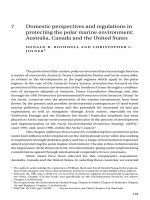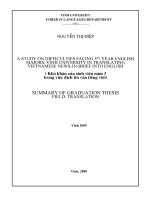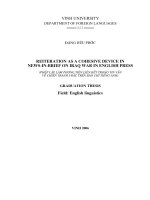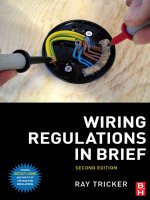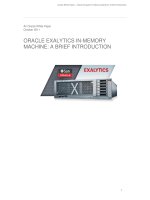Wiring regulations in brief
Bạn đang xem bản rút gọn của tài liệu. Xem và tải ngay bản đầy đủ của tài liệu tại đây (10.38 MB, 695 trang )
Wiring Regulations in Brief
To Claire
Wiring Regulations in Brief
A complete guide to the requirements of the17th Edition of the
IEE Wiring Regulations, BS 7671: 2008 and Part P of the Building
Regulations
Second edition
Ray Tricker
AMSTERDAM • BOSTON • HEIDELBERG • LONDON
NEW YORK • OXFORD • PARIS • SAN DIEGO
SAN FRANCISCO • SINGAPORE • SYDNEY • TOKYO
Butterworth-Heinemann is an imprint of Elsevier
Butterworth-Heinemann is an imprint of Elsevier
Linacre House, Jordan Hill, Oxford OX2 8DP
30 Corporate Drive, Suite 400, Burlington, MA 01803
First edition 2007
Reprinted 2007
Second edition 2008
Copyright © 2008, Raymond L. Tricker. Published by Elsevier Ltd,
All rights reserved.
The right of Raymond L. Tricker to be identified as the author of this work has been
asserted in accordance with the Copyright, Designs and Patents Act 1988
No part of this publication may be reproduced, stored in a retrieval system, or trans-
mitted in any form or by any means electronic, mechanical, photocopying, recording
or otherwise without the prior written permission of the publisher.
Permissions may be sought directly from Elsevier’s Science & Technology Rights
Department in Oxford, UK: phone (ϩ44) (0) 1865 843830; fax: (ϩ44) (0) 1865
853333; email: Alternatively you can submit your request
online by visiting the Elsevier web site at and
selecting Obtaining permission to use Elsevier material.
Notice
No responsibility is assumed by the publisher for any injury and/or damage to persons
or property as a matter of products liability, negligence or otherwise, or from any use
or operation of any methods, products, instructions or ideas contained in the material
herein. Because of rapid advances in the medical sciences, in particular, independent
verification of diagnoses and drug dosages should be made.
British Library Cataloguing in Publication Data
A catalogue record for this book is available from the British Library
Library of Congress Cataloging-in-Publication Data
A catalog record for this book is available from the Library of Congress
ISBN: 978-0-7506-8973-1
For information on all Butterworth-Heinemann publications
visit our web site at
Typeset by Charon Tec Ltd., A Macmillan Company. (www.macmillansolutions.com)
Printed and bound in the UK
08 09 10 10 9 8 7 6 5 4 3 2 1
This page intentionally left blank
Ray Tricker (MSc, IEng, FIET, FCMI, FCQI, FIRSE) is
the Principal Consultant of Herne European Consultancy –
a company specializing in Integrated Management
Systems – and an established Butterworth-Heinemann
author (39 titles). He served with the Royal Corps of
Signals (for a total of 37 years) during which time
he held various managerial posts culminating in his
being appointed as the Chief Engineer of NATO’s
Communication Security Agency (ACE COMSEC).
Most of Ray’s work since joining Herne has centred on
the European railways. He has held a number of posts with
the Union International des Chemins de fer (UIC), for
example, Quality Manager of the European Train Control
System (ETCS), European Union (EU) T500 Review
Team Leader, European Rail Traffic Management System (ERTMS) Users’ Group
Project Co-ordinator and HEROE (Harmonization of European Rail Rules) Project
Co-ordinator, and currently (as well as writing books for Butterworth-Heinemann!) he
is busy assisting small businesses from around the world (usually on a no-cost basis)
to produce their own auditable Quality Management Systems to meet the require-
ments of ISO 9001:2000. He is also a Consultant to the Association of American
Railroads (AAR) advising them on ISO 9001:2000 compliance, was recently
appointed as UKAS Technical Specialist for the assessment of Notified Bodies for the
Harmonization of the trans-European high-speed rail system, and, is currently the
Quality Manager for the Trinidad Rapid Rail Project – Programme Management
Consultancy who are overseeing the Design Stage of a brand-new, multi-billion dollar
Trinidadian railway system.
About the author
Contents
Preface xxiii
Acknowledgements xxxi
1 Introduction 1
1.1 Introduction 1
1.2 Historical background 2
1.3 What does the standard contain? 4
1.3.1 What about the standard’s numbering
system? 6
1.4 What are the objectives of the IEE Wiring
Regulations? 7
1.5 What is the legal status of the IEE Wiring
Regulations? 7
1.6 What do they cover? 8
1.6.1 Electrical installation 8
1.6.2 Electrical equipment 10
1.7 What effect does using the Regulation have
on other Statutory Instruments? 10
1.7.1 What is The Building Act 1984? 10
1.7.2 What is the Disability Discrimination Act 2005? 12
1.7.3 What are the Electricity at Work Regulations
1989? 13
1.7.4 What are the Fire Precautions (Workplace)
Regulations 1997? 16
1.7.5 What is the Health and Safety at Work Act 1974? 17
1.8 How are the IEE Wiring Regulations
implemented? 18
1.8.1 Statutory Instruments 18
1.8.2 CENELEC Harmonised Documents 20
2 Domestic buildings 22
2.1 The Building Act 1984 22
2.2 The Building Regulations 22
2.3 Approved Documents 23
2.4 What about the rest of the United Kingdom? 24
2.4.1 Scotland 24
2.4.2 Northern Ireland 24
viii Contents
2.5 Electrical Safety 26
2.5.1 What is the aim of Approved Document P? 26
2.5.2 Who is responsible for electrical safety? 27
2.5.3 What are the statutory requirements? 27
2.5.4 What types of building does Approved
Document P cover? 29
2.5.5 What is a competent fi rm? 30
2.5.6 What is a competent person responsible for? 30
2.5.7 Who is entitled to self-certify an installation? 30
2.5.8 When do I have to inform the local authority
Building Control Body? 31
2.5.9 What if the work is completed by a friend, a
relative or me? 33
2.5.10 What if the work is completed by a contractor or
an installer? 33
2.6 What inspections and tests will have to be completed
and recorded? 33
2.6.1 What should be included in the records of the
installation? 33
2.6.2 Where can I get more information about the
requirements of Part P? 34
2.7 Requirements from the Approved Documents 36
2.7.1 Part P – Electrical safety 37
2.7.2 Part M – Access and facilities for disabled people 37
2.7.3 Part L – Conservation of fuel and power 38
2.7.4 Part B – Fire safety 38
2.7.5 Design 39
2.7.6 Extensions, material alterations and material
changes of use 40
2.7.7 Electricity distributors responsibilities 40
2.7.8 Earthing 42
2.7.9 Electrical installations 43
2.7.10 Electrical installation work 45
2.7.11 Inspection and Test 46
2.7.12 Additional requirements and facilities for
disabled people 47
2.7.13 Electrical components and installations 48
3 Earthing 57
3.1 What is earth? 58
3.2 What is meant by ‘earthing’ and how is it used? 59
3.3 Advantages of earthing 60
3.4 What types of earthing system are there? 62
3.4.1 System classifi cation 63
3.4.2 TN systems 64
Contents ix
3.4.3 TN-C system 65
3.4.4 TN-S system 66
3.4.5 TN-C-S system 66
3.4.6 TT system 67
3.4.7 IT system 68
3.5 Earth fault loop impendence 68
3.6 Earthing points 70
3.7 Main earthing terminals 71
3.8 Earth electrodes 73
3.9 Earthing conductors 73
3.10 Requirements from the Regulations 73
3.10.1 Additions and alterations to an installation 73
3.10.2 Automatic disconnection of supply 74
3.10.3 Autotransformers and step-up transformers 74
3.10.4 Cables 75
3.10.5 Earthing conductors 76
3.10.6 Earth electrodes 77
3.10.7 Earth fault current 78
3.10.8 Earth faults 78
3.10.9 Earthing arrangements 79
3.10.10 Earthing conductors 81
3.10.11 Earthing systems 81
3.10.12 Electrical separation 81
3.10.13 Electrical services 82
3.10.14 Emergency switching 82
3.10.15 Earthing terminals or bars 82
3.10.16 Fault protection 84
3.10.17 High leakage current 85
3.10.18 Isolation 85
3.10.19 Protective and neutral (PEN) conductors 85
3.10.20 Protective bonding conductors (PME) 86
3.10.21 Protective conductors 86
3.10.22 Protective devices 87
3.10.23 Protective devices and switches 87
3.10.24 Protective earthing 88
3.10.25 Protective measures 89
3.10.26 RCDs 89
3.10.27 Requirements for SELV and PELV circuits 90
3.10.28 Sources 90
3.10.29 Warning notices: earthing and bonding connections 91
3.10.30 Warning notices: periodic inspection and testing 91
3.10.31 Testing 92
3.10.32 Special locations an installations 95
3.10.33 TN System 102
3.10.34 TN-C system 105
3.10.35 TN-S system 106
x Contents
3.10.36 TN-C-S system 106
3.10.37 TT system 108
3.10.38 IT system 111
4 Safety protection 119
4.1 Basic safety requirements 120
4.1.1 Mandatory requirements 120
4.1.2 Fundamental safety requirements 120
4.1.3 Building Regulations requirements 123
4.1.4 Design, installation, inspection and testing of
electrical installations 123
4.1.5 Protection from electric shock 125
4.2 Basic protection against electric shock 126
4.2.1 Protection by insulation of live parts 126
4.2.2 Protection by barriers or enclosures 128
4.2.3 Protection by obstacles and placing out
of reach 128
4.2.4 Protection by RCDs 128
4.2.5 Requirements from the Regulations – basic
protection against electric shock 129
4.3 Fault protection (protection against indirect contact) 134
4.3.1 Protection by earthed equipotential bonding and
automatic disconnection of supplies (EEBADS) 135
4.3.2 Protection by non-conducting location 136
4.3.3 Protection by obstacles and placing out of reach 136
4.3.4 Protection by Class II equipment or equivalent
insulation 136
4.3.5 Requirements from the Regulations – fault protection
against electric shock 137
4.4 Protection against both direct and indirect contact 138
4.4.1 Protection by SELV 139
4.4.2 Limitation of discharge of energy 139
4.5 Additional requirements 139
4.5.1 Protective bonding conductors 139
4.5.2 Main equipotential bonding conductors 141
4.5.3 Supplementary bonding conductors 142
4.5.4 Protective conductors 143
4.5.5 Protective equipment (devices and switches) 144
4.5.6 Protection against overvoltage 144
4.5.7 Requirements from the regulations 145
5 Electrical equipment, components, accessories and supplies 173
5.1 Installation 173
5.2 Ceiling roses 174
Contents xi
5.3 Circuit-breakers 175
5.3.1 Locations with risks of fi re due to the nature of
processed or stored materials 175
5.3.2 Protection against fault current only 176
5.4 Electric motors 177
5.5 Fuses 178
5.5.1 Protection against fault current only 178
5.5.2 Devices for protection against overcurrent 178
5.5.3 Functional switching devices 179
5.5.4 Electrode water heaters and boilers 179
5.5.5 Devices for isolation and switching 180
5.6 Heaters 181
5.6.1 Electrode water heaters and boilers 182
5.6.2 Heaters for liquids or other substances having
immersed heating elements 182
5.6.3 Water heaters having immersed and uninsulated
heating elements 183
5.6.4 Electric surface heating systems 183
5.6.5 Electric fl oor heating systems 184
5.6.6 Floor and ceiling heating systems 184
5.7 Isolators 188
5.8 Lampholders 188
5.8.1 Polarity 189
5.9 Luminaires 189
5.9.1 Mobile equipment 191
5.9.2 Outdoor lighting installation 191
5.9.3 General requirements for installations 191
5.9.4 Protection against fi re 192
5.9.5 Wiring systems 192
5.9.6 Independent lamp controlgear, e.g. ballasts 194
5.9.7 Stroboscopic effect 195
5.9.8 Requirements for outdoor lighting installations,
highway power supplies and street furniture 195
5.9.9 Double or reinforced insulation 197
5.9.10 Underwater luminaires for swimming pools 197
5.9.11 Luminaires in fountains 198
5.9.12 Luminaires and lighting installations in agricultural
and horticultural premises 198
5.9.13 Luminaires and lighting installations in exhibitions
shows and stands 198
5.9.14 Electric discharge lamp installations 199
5.9.15 Luminaires in caravans and motor
caravans 199
5.9.16 Luminaires in temporary installations 200
5.10 Mobile equipment 201
xii Contents
5.11 Plug and socket outlets 202
5.11.1 Caravan and camping parks 204
5.11.2 Marinas and similar locations 205
5.11.3 Exhibitions, shows and stands 206
5.11.4 Mobile and transportable units 206
5.11.5 Temporary electrical installations 206
5.12 Protection by RCDs 207
5.12.1 Construction 208
5.12.2 Installation 208
5.12.3 Locations containing a bath or shower 209
5.12.4 Swimming pools and other basins 210
5.12.5 Power supply 210
5.12.6 TN systems 211
5.12.7 TT system 212
5.12.8 IT system 213
5.12.9 Devices for protection against the risk of fi re 214
5.12.10 Electrode water heaters and boilers 214
5.12.11 Outdoor lighting installation 214
5.13 Residual current monitor (RCM) 214
5.14 Rotating machines and motors 215
5.15 Supplies 216
5.15.1 Consumer units 217
5.15.2 Batteries 217
5.15.3 Generating sets 219
5.16 Switches 222
5.16.1 Protective devices 223
5.16.2 Switchgear 224
5.16.3 Switching devices 225
5.16.4 Isolation and switching 225
5.16.5 Devices for isolation and switching 225
5.16.6 Single-pole switching devices 226
5.16.7 Main switches 226
5.16.8 Main linked switches 227
5.16.9 Emergency switching 227
5.16.10 Functional switching devices 229
5.16.11 Firefi ghter’s switches 230
5.16.12 Switchboards 231
5.16.13 Mechanical maintenance 232
5.16.14 Lighting installations 233
5.16.15 Special installations and locations 233
5.17 Rectifi ers 236
5.17.1 Temporary installations 237
5.18 Transformers 237
5.18.1 Safety isolating transformers 237
5.18.2 Autotransformers and step-up transformers 238
5.18.3 ELV transformers and electronic converters 238
Contents xiii
5.18.4 IT systems 238
5.18.5 Electric dodgems 239
6 Cables and conductors 240
6.1 Cables 240
6.1.1 General 241
6.1.2 Single-core cables 241
6.1.3 Multicore cables 242
6.1.4 Flexible cables 243
6.1.5 Heating cables 245
6.1.6 Electric fl oor heating systems 246
6.1.7 Armoured single-core cables 246
6.1.8 Building design 246
6.1.9 Cable conduit, ducting, trunking, tray and ladder
systems 246
6.1.10 Cable couplers 247
6.1.11 Cables in thermal insulation 247
6.1.12 Connection of multiwire, fi ne wire and very fi ne
wire conductors 247
6.1.13 Cross-sectional areas of conductors of cables 248
6.1.14 Current-carrying capacities of cables 248
6.1.15 Earth electrodes 248
6.1.16 Electrical connections to bare connectors and/or
busbars 249
6.1.17 Electrode water heaters and boilers 249
6.1.18 Electromechanical stresses 249
6.1.19 Fire propagating structures 249
6.1.20 Fault current protective devices 250
6.1.21 Groups containing more than one circuit 250
6.1.22 Heating conductors and cables 250
6.1.23 Identifi cation of conductors 251
6.1.24 Impact 251
6.1.25 Inspection 253
6.1.26 Lifts and/or the proximity to non-electrical services 253
6.1.27 Locations with risks of fi re due to the nature of
processed or stored materials 253
6.1.28 Luminaires 254
6.1.29 Mechanical stresses 254
6.1.30 Omission of identifi cation by colour or marking 255
6.1.31 Precautions within a fi re-segregated compartment 256
6.1.32 Protective conductor 256
6.1.33 Reduced low-voltage system 256
6.1.34 Requirements for SELV and PELV circuits 256
6.1.35 Rotating machines 257
6.1.36 Telecommunication cables 257
xiv Contents
6.1.37 Temperature 257
6.1.38 Types of wiring system 257
6.1.39 Underground cables 258
6.1.40 Vibration 258
6.1.41 Wiring systems 258
6.1.42 Special installations and locations 260
6.2 Conductors 267
6.2.1 General 268
6.2.2 Types of protective conductor 268
6.2.3 Automatic disconnection in case of a fault 269
6.2.4 Bare conductors 269
6.2.5 Equipotential bonding conductor 272
6.2.6 Non-earthed equipotential bonding conductor 272
6.2.7 Main protective bonding conductors 273
6.2.8 Supplementary equipotential bonding 273
6.2.9 Building design 275
6.2.10 Cable couplers 276
6.2.11 Cross-sectional area of conductors 276
6.2.12 Conductors in parallel 277
6.2.13 Current-carrying capacities of conductors 278
6.2.14 Earthing conductors 278
6.2.15 Earthing requirements 279
6.2.16 Main earthing terminals or bars 280
6.2.17 Electric fl oor heating systems 283
6.2.18 Electrical connections 284
6.2.19 Electrical installations 285
6.2.20 Electrode water heaters and boilers 286
6.2.21 Electromechanical stresses 287
6.2.22 Emergency switching 287
6.2.23 Enclosures 287
6.2.24 Fault protection 287
6.2.25 Fault protection 288
6.2.26 Ferromagnetic enclosures: electromagnetic effects 288
6.2.27 Final circuits 288
6.2.28 Fire risk 289
6.2.29 Fuses 289
6.2.30 Functional switching 289
6.2.31 Harmonic currents 290
6.2.32 Identifi cation of conductors 290
6.2.33 Identifi cation of conductors by letters and/or
numbers 292
6.2.34 Notices 293
6.2.35 Installation 294
6.2.36 Inspection 295
6.2.37 Isolation 295
6.2.38 Line conductors 296
Contents xv
6.2.39 Live conductors 296
6.2.40 Low-voltage generating sets 299
6.2.41 Luminaires 299
6.2.42 Mechanical stresses 300
6.2.43 Multiwire, fi ne wire and very fi ne wire
conductors 300
6.2.44 Neutral conductor 301
6.2.45 Non-conducting location 302
6.2.46 Multicore cables, conduits, ducting systems,
franking systems or tray or ladder systems 302
6.2.47 Multiphase circuits 303
6.2.48 Operational conditions 303
6.2.49 Overhead conductors 303
6.2.50 Parallel conductors 303
6.2.51 Plug and socket outlets 304
6.2.52 Protective conductors 304
6.2.53 PEN conductors 308
6.2.54 Protection against fault current 310
6.2.55 Protection against fi re 311
6.2.56 Protection against overcurrent 312
6.2.57 Protection against overload current 312
6.2.58 Protection by earth-free local equipotential
bonding 313
6.2.59 Protective conductors 314
6.2.60 Protective devices and switches 315
6.2.61 Protective earthing 315
6.2.62 Protective equipotential bonding 316
6.2.63 Protective multiple earthing 317
6.2.64 RCDs 317
6.2.65 SELV and PELV circuits 318
6.2.66 Supply source 319
6.2.67 Transformers 319
6.2.68 Testing 320
6.2.69 Wiring systems 321
6.3 Conduits, cable ducting, cable trunking, busbar or
busbar trunking 323
6.3.1 Ducting and trunking 324
7 Special installations and locations 330
7.1 General requirements 331
7.1.1 Accessibility 331
7.1.2 Electrical heating units 331
7.1.3 Equipotential bonding conductors 332
7.1.4 Forced air heating systems 332
7.1.5 Heating appliances 332
xvi Contents
7.1.6 Heating conductors and cables 333
7.1.7 Hot water and/or steam appliances 333
7.1.8 Locations with risks of fi re due to the nature of
processed or stored materials 333
7.1.9 Overhead wiring systems 334
7.1.10 Type of demand 337
7.1.11 Water heaters and boilers 337
7.2 Special installations and locations 338
7.2.1 Agricultural and horticultural premises 338
7.2.2 Conducting locations with restricted movement 338
7.2.3 Construction and demolition sites 338
7.2.4 Electrical installations in caravan/camping parks
and similar locations 338
7.2.5 Electrical installations in caravans and motor
caravans 339
7.2.6 Exhibitions, shows and stands 339
7.2.7 Floor and ceiling heating systems 339
7.2.8 Locations containing a bath or shower 339
7.2.9 Marinas and similar locations 339
7.2.10 Mobile and transportable units 340
7.2.11 Rooms and cabins containing saunas 340
7.2.12 Solar, photovoltaic (PV) power supply systems 340
7.2.13 Swimming pools and other basins 340
7.2.14 Temporary electrical installations for structures,
amusement devices and booths at fairgrounds,
amusement parks and circuses 340
7.3 Requirements from the Regulations 340
7.3.1 Agricultural and horticultural premises 340
7.3.2 Conducting locations with restricted movement 348
7.3.3 Construction and demolition site installations 349
7.3.4 Electrical installations in caravan/camping parks
and similar locations 353
7.3.5 Electrical installations in caravans and motor
caravans 357
7.3.6 Exhibitions, shows and stands 363
7.3.7 Floor and ceiling heating systems 368
7.3.8 Locations containing a bath or shower 372
7.3.9 Marinas and similar locations 377
7.3.10 Mobile and transportable units 382
7.3.11 Rooms and cabins containing saunas 385
7.3.12 Solar, pholtovoltaic (PV) power supply
systems 388
7.3.13 Swimming pools and other basins 393
7.3.14 Temporary electrical installations for structures,
amusement devices and booths at fairgrounds,
amusement parks and circuses 400
Contents xvii
8 External infl uences 409
8.1 Environmental factors and infl uences 410
8.1.1 Combined environmental factors 410
8.1.2 Sequences of environmental factors 410
8.1.3 Environmental application 410
8.1.4 Environmental conditions 411
8.1.5 Equipment situations 412
8.1.6 Requirements from the Regulations – General
environmental conditions 413
8.1.7 Requirements from the Regulations – General
external infl uences 413
8.2 Ambient temperature 415
8.2.1 Electrical installations 417
8.2.2 Typical requirements – ambient temperature 418
8.2.3 Requirements from the Regulations – ambient
temperature 419
8.3 Solar radiation 428
8.3.1 What are the effects of solar radiation? 429
8.3.2 Photochemical degradation of material 431
8.3.3 Effects of irradiance 431
8.3.4 Heating effects 432
8.3.5 Typical requirements – solar radiation 432
8.3.6 Requirements from the Regulations – solar radiation 433
8.4 Humidity 433
8.4.1 What is humidity? 434
8.4.2 Relative and absolute humidity and their effect on
equipment performance 434
8.4.3 Condensation 435
8.4.4 Adsorption 435
8.4.5 Absorption 435
8.4.6 Diffusion 436
8.4.7 Protection 436
8.4.8 Typical requirements – humidity 436
8.4.9 Requirements from the Regulations – humidity 437
8.5 Air Pressure and altitude 438
8.5.1 Low air pressure 439
8.5.2 Typical requirements – air pressure and altitude 439
8.6 Weather and precipitation 440
8.6.1 Water 441
8.6.2 Salt water 442
8.6.3 Ice and snow 442
8.6.4 Weathering 442
8.6.5 Typical requirements – weather and precipitation 443
8.6.6 Requirements from the Regulations – weather and
precipitation 444
xviii Contents
8.7 Pollutants and contaminants 446
8.7.1 Pollutants 447
8.7.2 Contaminants 448
8.7.3 Typical requirements – pollutants and contaminants 453
8.7.4 Requirements from the Regulations – pollutants
and contaminants 454
8.8 Mechanical 456
8.8.1 Shock 456
8.8.2 Vibration 456
8.8.3 Acceleration 457
8.8.4 Protection 457
8.8.5 Typical requirements – mechanical 457
8.8.6 Requirements from the Regulations – mechanical 458
8.9 Electromagnetic compatibility 462
8.9.1 Typical requirements 462
8.9.2 Requirements from the Regulations – electromagnetic
compatibility 463
8.10 Fire 466
8.10.1 Fire growth 466
8.10.2 Flashover 467
8.10.3 Characteristics of smoke and gases as a fi re
product 469
8.10.4 Building designs 471
8.10.5 Test Standards 471
8.10.6 Other related standards and specifi cations 471
8.10.7 Typical contract requirements – fi re 472
8.10.8 Requirements from the Regulations – fi re 473
9 Inspection and testing 485
9.1 What inspections and tests have to be completed and
recorded? 486
9.2 Inspections 486
9.2.1 General 486
9.2.2. Inspection check list 486
9.2.3 Requirements from the Regulations – inspection 489
9.3 Testing 490
9.3.1 Initial inspection and tests 490
9.3.2 Protective measures 491
9.3.3 Design requirements 495
9.3.4 Electricity distributor 495
9.3.5 Site insulation 495
9.3.6 Insulation resistance 495
9.3.7 Protection against direct and indirect contact 497
9.3.8 Protection against direct contact 499
9.3.9 Protection against indirect contact 503
Contents xix
9.3.10 Additional tests with the supply connected 514
9.3.11 Insulation tests 518
9.3.12 Verifi cation tests 522
9.3.13 Electrical connections 525
9.3.14 Tests for compliance with the Building
Regulations 526
9.3.15 Additional tests required for special installations
and locations 528
9.4 Identifi cation and notices 531
9.4.1 General 531
9.4.2 Conductors 531
9.4.3 Identifi cation of conductors by letters and/or
numbers 533
9.4.4 Omission of identifi cation by colour or marking 533
9.4.5 Diagrams 533
9.4.6 Warning notices 534
9.5 What type of certifi cates and reports are there? 538
9.5.1 Electrical Installation Certifi cate 539
9.5.2 Minor Electrical Installation Works Certifi cate 540
9.5.3 Periodic inspection 542
9.6 Test requirements specifi c for compliance with the
Building Regulations 545
9.6.1 Mandatory requirements 545
9.6.2 Inspection and test 550
9.6.3 Extensions, material alterations and material
changes of use 550
9.6.4 Design 551
9.6.5 Electricity distributors responsibilities 551
9.6.6 Consumer units 551
9.6.7 Earthing 551
9.6.8 Electrical installations 552
9.6.9 Wiring and wiring systems 552
9.6.10 Socket outlets 553
9.6.11 Switches 554
9.6.12 Telephone points and TV sockets 554
9.6.13 Equipment and components 555
9.6.14 Thermostats 557
9.6.15 Lighting 558
9.6.16 Lecture/conference facilities 558
9.6.17 Cellars or basements 558
9.7 What about test equipment? 559
9.7.1 Control of inspection, measuring and test
equipment 561
9.7.2 Computers 561
9.7.3 Software 561
9.7.4 Calibration 561
xx Contents
9.7.5 Calibration methods 562
9.7.6 Calibration frequency 562
9.7.7 Calibration ideals 563
9.8 Requirements from the Regulations – testing 563
9.8.1 Protective systems 564
9.8.2 Other tests 566
9.8.3 Certifi cation and reporting 570
Appendix 9.1: Examples of test equipment used to test
electrical installations 573
A9.1.1 Continuity tester 573
A9.1.2 Insulation resistance tester 574
A9.1.3 Loop impedance tester 575
A9.1.4 RCD tester 575
A9.1.5 Prospective fault current tester 576
A9.1.6 Test lamp or voltage indicator 577
A9.1.7 Earth electrode resistance 577
10 Installation, maintenance and repair 579
10.1 General 580
10.2 Installation 581
10.2.1 Design 581
10.2.2 Installation of equipment 583
10.2.3 Power supplies 583
10.2.4 Earthing 584
10.2.5 Cables 584
10.2.6 Conductors 585
10.2.7 Wiring systems 585
10.2.8 Protective devices 586
10.2.9 Electromechanical stresses 588
10.2.10 Electromagnetic comparability 588
10.2.11 Thermal effects 588
10.2.12 Initial verifi cation 588
10.3 Maintenance and repair 589
10.3.1 Frequency of inspection and testing 591
10.3.2 Accessibility of electrical equipment 591
10.3.3 Safety protection 592
10.3.4 Switching off for mechanical maintenance 593
10.3.5 Devices for switching off for mechanical
maintenance 593
10.3.6 Connections 594
10.3.7 Insulating enclosure 594
10.3.8 Low power supply sources 594
10.3.9 Multiphase sequence 594
10.3.10 Environmental aspects 595
Contents xxi
10.4 Repair 595
10.4.1 Disconnecting devices 595
10.4.2 Accessibility of electrical equipment 596
10.4.3 Certifi cation and reporting 596
10.5 Additions and alterations to an installation 597
10.5.1 Additions and alterations to an installation 597
10.6 Material changes of use 598
Appendix 10.1: Example stage audit checks 600
Appendix A Symbols used in electrical installations 605
Appendix B List of electrical and electromechanical symbols 606
Appendix C SI units for existing technology 609
Appendix D Acronyms and abbreviations 614
Appendix E British Standards currently used with the
Wiring Regulations 617
Appendix F Useful contacts and further information 637
Appendix G Books by the same author 641
Index 645
This page intentionally left blank
The Industrial Revolution during the 1800s was responsible for causing poor
living and working conditions in ever-expanding, densely populated urban
areas. Outbreaks of cholera and other serious diseases (through poor sanita-
tion, damp conditions and lack of ventilation) forced the government to take
action. Building control took on the greater role of Health and Safety through
the first Public Health Act in 1875 and this eventually led to the first set of
national building standards (i.e. the Building Regulations).
As is the case with most official documents, as soon as they were published,
they were almost out of date and consequently needed revising. So it wasn’t
too much of a surprise to learn that the committee responsible for writing
the Public Health Act of 1875 had overlooked the increased use of electric
power for street lighting and/or domestic purposes. Electricity was beginning
to become increasingly popular but, as there were no rules and regulations
governing their installation at that time, the companies or person responsible
simply dug up the roads and laid the cables as and where they felt like it!
From a Health and Safety point of view the Government of the day
expressed extreme concern at this exceedingly dangerous situation and so
in 1882 The Electric Lighting Clauses Act (modelled on the previous 1847
Gas Act ) was passed by Parliament. This legislation was implemented by
Rules and Regulations for the prevention of Fire Risks Arising from Electric
Lighting and it is this document that is the forerunner of today’s IEE Wiring
Regulations. Since then, this document has seen a succession of amend-
ments, new editions and new titles and has now become the 17th edition of
the IEE Wiring Regulations (i.e. BS 7671:2008 ‘ Requirements for Electrical
Installations ’ ).
The current legislation for all Building Control is the Building Act 1984,
which is implemented by the Building Regulations 2000 and these Building
Regulations are a set of minimum requirements designed to secure the health,
safety and welfare of people in and around buildings and to conserve fuel and
energy in England and Wales. They are basic performance standards which
are supported by a series of documents that correspond to the different areas
covered by the regulations. These are called ‘ Approved Documents ’ and they
contain practical and technical guidance on ways in which the requirements
of the Building Act 1984 can be met.
Since the introduction of the Public Health Act in 1875 there has always,
therefore, been a direct link between Electrical Installations and Building
Control and parts of all of the Approved Documents have an affect on
these sorts of installation. With the publication of Approved Document P
Preface
xxiv Preface
for ‘ Electrical Safety ’ in 2005, however, the design, installation, inspection
and testing of electrical installations has now become inextricably linked to
Building Control and the purpose of this book is attempt to draw all of the
various requirements together.
Over the past 120 years there have been literally hundreds of books written
on the subject of electrical installations, but the aim of Wiring Regulations
in Brief is not just to become another book on the library shelf to be occa-
sionally looked at. The intention is that it will provide professional engineers,
students and (i.e. to a lesser degree) the unqualified DIY fraternity with an
easy-to-read reference source to the official requirements of BS 7671:2008
for electrical safety and electrical installations.
Although BS7671:2008 is well structured and has separate sections for all
the main topics (e.g. safety protection, selection and erection of equipment
and so on) it is not the easiest of standards to get to grips with for a particular
situation. Occasionally it can be very confusing and requires the reader to
constantly flick backwards and forwards through the book to find what it is
all about.
For example, Regulation 411.4.7 states that: ‘Where a circuit-breaker
is used to satisfy the requirements of Regulation 411.3.2.2 or Regulation
411.3.2.3, the maximum value of earth fault loop impedance (Z
s
) shall be
determined by the formula in Regulation 411.4.5. Alternatively, for a nominal
voltage (U
o
) of 230 V and a disconnection time of 0.4 s in accordance with
Regulation 411.3.2.2 or 5 s in accordance with Regulation 411.3.2.3, the values
specified in Table 41.3 for the types and ratings of overcurrent devices listed
may be used instead of calculation. ’
The intention of Wiring Regulations in Brief , therefore, is to peel away
some of this confusion and ‘ officialise ’ and provide the reader with an
on-the-job reference source that can be quickly used without having to delve
backwards and forwards though the standard.
Please note, however, that this is only the author’s impression of the most
important aspects of the Wiring Regulations and their association with the
Building Regulations. It should, therefore, only be treated as an aide mémoire
to the Regulations and electricians should always consult BS 7671 to satisfy
compliance.
Main changes in the 2008 edition of BS 7671
Following a full review, the 17th edition of the IEE Wiring Regulations BS
7671:2008 replaces the previous 2001 16th edition.
Technical authority for this Standard is vested in the Joint IET/BSI
Technical Committee JPEL/64. This Joint Technical Committee is responsible
for the work previously undertaken by the IEE Wiring Regulations Technical
Committee and the BSI Technical Committee PEL/64. Copyright is held
jointly by the IET and BSI.

